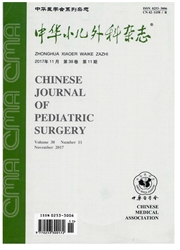

 中文摘要:
中文摘要:
目的 探讨Notch信号通路在小儿胆道畸形发病机制中的作用.方法 收集23例胆道畸形患儿临床资料(胆道闭锁12例,胆总管扩张11例),术中取肝脏组织样本;9例正常肝脏组织样本作为正常对照.免疫组化方法和实时荧光定量PCR方法检测肝脏组织中的Notch配体、受体的表达分布和相对表达量.结果 Jag1在胆道闭锁增生胆管表达明显增强,Jag2在各组门管区表达为阴性;荧光定量PCR显示:胆道闭锁组及胆总管扩张组Jag1 mRNA的表达明显高于对照组(P<0.01);Jag2 mRNA的表达在三组问差异无统计学意义(P>0.05).Notch1、Notch 2在对照组及胆总管扩张组主要表达于肝细胞和成熟胆管细胞,胆道闭锁组胆管细胞无阳性表达.Notch 3在胆道闭锁汇管区新生血管、基质中有较为明显的表达.荧光定量PCR显示:Notch1、Notch 2mRNA的表达在三组间差异无统计学意义(P>0.05),胆道闭锁组Notch 3 mRNA的表达高于对照组(0.013±0.003比0.009±0.003,P<0.01).Notch 4表达为阴性.结论 胆道闭锁肝脏组织Notch配体、受体表达异常,增生胆管细胞Jag1的过表达及Notch受体表达缺陷可能参与了胆道闭锁的病理过程.
 英文摘要:
英文摘要:
Objective To investigate the expressions of Notch ligands and its receptors in the liver tissues of the pediatric patients with bile duct malformations. Methods Twenty three patients including 12 patients with biliary atresia and 11 with choledochal cyst were enrolled in this study. The patients' liver specimens were harvested during surgery. Immunohistochemistry and real-time fluorescent quantitative RT-PCR were performed to examine the expression of Notch ligands and its receptors in the liver tissues. Nine health liver tissues served as controls. The clinical data of these patients were also collected and analyzed. Results The expression of Jag1 significantly increased in the proliferating ductules of the patients with biliary atresia. Jag2 was negative in the portal area of all patients. The mRNA of Jag1 of the patients with bile duct malformations was higher than that of controls (P〈0. 01). No difference of the mRNA of Jag2 was found between the bile duct malformation patients and the controls (P〉0. 05). The expression of Notch 1 and Notch 2 was mostly found in hepatocytes and bile ductules of the controls' and the choledochal cyst patients' liver tissues. No Notch 1 and Notch 2 expression was found in proliferating ductules of the biliary atresia patients. Notch 3 was expressed in the neovascularization and mesenchyme of the biliary atresia patients. There was no significant difference of Notch1 and Notch 2 mRNA between the biliary atresia patients, choledochal cyst patients and controls (P〉0. 05). Notch 3 mRNA of biliary atresia patients was higher than that of the controls (P 〈0. 01). Notch 4 expression was undetectable in all patients. Conclusions The expression patterns of Notch ligands and its receptors are changed in the patients with biliary atresia,which may contribute to the pathogenesis of biliary atresia.
 同期刊论文项目
同期刊论文项目
 同项目期刊论文
同项目期刊论文
 期刊信息
期刊信息
